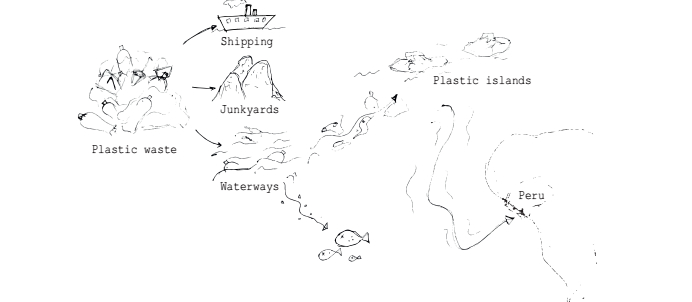Plastic exist in a large part of our daily lives. The plastic lid on our coffee to go, the plastic bags to bring our groceries home, straws in your soda and even plastic cell phone cases. And that’s just a part of the total amount we encounter daily. Over the last ten years we have produced more plastic than during the whole last century. (Ecowatch& Hasselberger, 2014) Plastic has become an epidemic. But, where does all this plastic go? Some of it is shipped overseas, somewhat ends up in junkyards and more than you can imagine ends up on the loose as plastic pollution, eventually making its way into waterways. Plastic in the ocean breaks down into such small segments that pieces of plastic from a one liter bottle could end up on every mile of beach throughout the world. (Ecowatch& Hasselberger, 2014) The loose pieces of plastic flow along the ocean streams and end up in 5 stacks of garbage around the world called ‘plastic islands’. (See Fig.1) It takes 500-1,000 years for plastic to degrade. The plastic pollution problem is not only a problem for the earth and its ecosystems, it’s also bad for our health. In the western countries there exist some recycle-techniques in order to make reuse of the plastic. In other countries in contradiction, there is no or almost no such system as recycling. Peru is one of the countries with the highest amount of plastic waste. From the marine trash 50% contains plastic. Almost none of this plastic waste is being recycled. In 2013, an average household in Peru produces 0,8 kg waste. In 2021 this amount will be more than doubled and will be 2 kg. Only 5% of this waste is being recycled (Ortiz, 2013). From all this waste, plastic forms the greatest threat for the environment.
Recycling
In Peru the recycling business is barely regulated. This process depends on a couple of hundred thousand people called ‘recicladors’ sifting through the garbage to sort out what is valuable Central Intelligence Agency (2013). For a problem of this magnitude, the sifting through the garbage is not enough and more needs to be done in order to solve this pollution problem in Peru. Since recycling systems in Peru are not present like in Europe, the challenging of this problem has to be done by another source: the people themselves. And that can only happen if there exists awareness of the plastic pollution problem among the Peruvian population. It is highly important that something is being done about this growing problem. Awareness can be created by notifying people about the problem and its consequences and at the same time showing people how they can contribute to an amelioration of the future. Only informing people of the problem is not enough, further steps are needed: active awareness. The company L.O.O.P.(Life Out Of Plastic) has been involved in this issue for quite some time now. Since 2012 they are trying to make people aware of the problem, its consequences and how people could contribute themselves. To enhance these actions, to show people the possibilities of plastic and to make money to expand their company, L.O.O.P. also sells products made out of plastic bottles.
